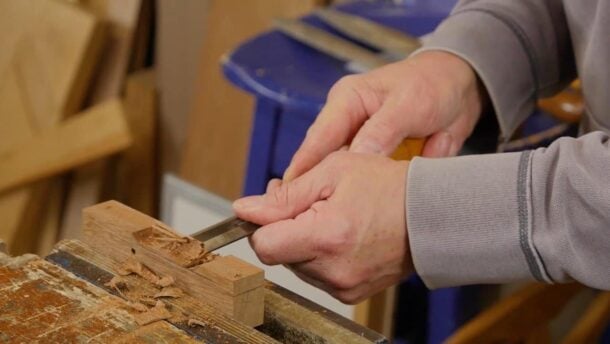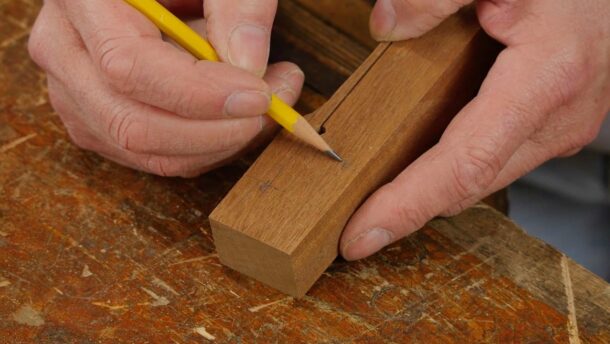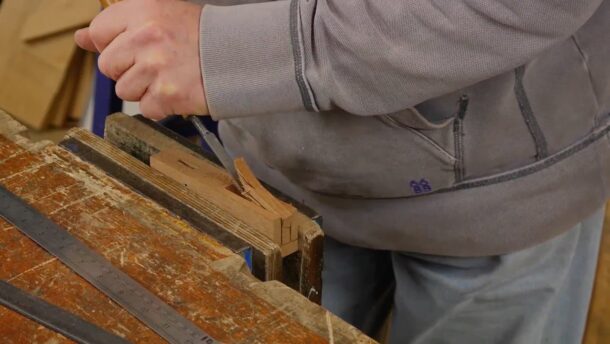Cam Clamp – Project Info
Posted 8 March 2016
This is the introduction for a free series. Want to watch the whole thing? It is free to do so, you just need to log into the site, and you can enjoy this series and many other videos we think you will love.
Description
Cam clamps are handy little clamps that are useful for small, as well as delicate, projects and are great to have around the shop. In this series, Paul goes through the full process of making cam clamps by hand for very little cost.
The tools you will need are:
- Knife
- Square
- Combination or marking gauge
- Tape/Ruler (or both)
- Chisel hammer
- 1/8″, 3/8″ and 1″ Chisel
- Smoothing plane (No 4)
- Handsaw*
- Tenon saw
- Card scraper
- Brace & bit/hand drill/drill driver
- Rasp*
- File
- Small steel hammer
* = optional
Cutting list
Hardware
1 Stem bar 1/8″ x 3/4″ x 11 1/2″ (optional) Can use stock that is 1/8″-1/4″ thick according to preference, desired weight and availability.
5 Roll pins 4mm (or 1/8″ to 5/32″) x 1 1/2″ to be cut down flush on fixing. Off cut used for stop in the end of the stem bar.
Leather
2 Cushion pads 1 1/4″ x 1″ Leather (or cork)
Wooden Components
| Part | Qty | Size |
| Sliding head | 1 | 1″ x 1 1/2″ x 6″ |
| Fixed head | 1 | 1″ x 1 1/2″ x 6″ |
| Cam | 1 | 3/8″ x 1 3/16″ x 4 1/2″ |




Paul,
Your attention to detail & meticulous work reminds me of my Grandfathers & Father, who were engineers, and cabinet maker/builders. I was allowed to use workshop, tools & materials of a quality anyone would die for today, provided I had a plan to show them with a list of material/ cutting list etc.
I was shown how not to hit my thumb with the hammer by using both hands on the hammer(workplace health & safety), as well as how to use & lookafter the tools.
You are giving a great deal to many people I’m certain.
It’s my turn to teach Grandchildren now, but I could never achieve the best result without your help.
Regards,
David
Some projects strike a cord. This one has for me and I’m having a blast making my own cam clamps.
Thanks!!
Thank you Paul for another no nonsense (and relatively dust free) approach to woodworking.
I’ve taken the original diagrams that were posted for this project and tweaked them a bit to make them easier to read and corrected the perspective issues with the second diagram showing the cam measurements themselves. I hope other might find them useful. They are located on my Google Drive:
https://drive.google.com/folderview?id=0B5FZ2WIuZgfGWERPbG9oeWFiY3c&usp=sharing
I hope they help.
Rich
To Rich Adams: Thank’s very much!
Hi Rich,
I can’t see your tweaked diagrams… I’m having difficulty reading Paul’s so I’d appreciate seeing yours.
Have you removed them?
Thanks, in advance,
Matt
This Google Drive folder appears to be empty. Can the cam info be obtained elsewhere?
Hello Gregory, have you spotted the initial drawings linked to above the description? That should have all the information you need.
Thanks, Philip. I did see that but all I could see on the second page were figures but no drawings. I’ve adjusted brightness and contrast in Photoshop and now I can see it all.
Hi Gregory,
Thanks for pointing this out, this is something we are currently working on and will replace these with a clearer version.
Kind Regards,
Izzy
I can see the diagrams, but the 2nd page is so faint, I can barely make out some of the drawings. The measurements are ok to read, though faint. The picture of the cam looks like very light grey writing on white, with some spots completely invisible. I printed it extra dark and the other drawings are somewhat legible now, but not the cam.
If you print the drawings and you’re using a colour printer, change the printer setting to ‘print Greyscale’ or ‘Print colours as shades of Black’. That may help.
If you can capture the drawings in Photoshop or Paintshop, reduce the Colour-Depth to convert shades of grey to black.
Are you using a 12v or 18v hand drill?
Most likely 18v but 12 should do fine also. He uses it in the first gear, I believe, since the holes come out cleaner at slower speeds.
Still, sharp bits are much more important than the thing moving it, even though DeWalts are very nice in the hand.
Watched the vids a couple of times, then built a clamp, but used screw thread instead of a cam as I needed to tighten a bit more over a 750 mm length. Great stuff, will now make some smaller as per Pauls video.
Thanks for the videos. I’ve made four of these clamps and they are all working well, but, that’s not enough so I’m going to make four more.
Thank you Paul and Team.
This is great, as I need these for a Ukulele build I am doing with my daughter. I built 2 of them, however they aren’t staying tight unless I turn the cam almost 180 degrees. If I tighten up around 90 degrees or less the pressure just pushes the cam back. Am I missing something?
Hi Steve,
Paul says:
Not really, sometimes depending on the wood, wood type and the distance, this cam compression can vary remarkably. Try using some rosin, which you get for violin strings, onto the circumference of the cam, this will help the cam stick.
Kind Regards,
Izzy
Great thanks! I strip sanded the cam a bit and then put some rosin on as suggested. My daughter had some from gymnastics or softball? Not sure, either way, the clamp works like a champ now! Hope that tidbit helps anyone else who has that problem. and the ukulele is coming along nicely, though i think i’ll have to make one of these clamps thinner to get into the sound hole to clamp the bridge on. Should be interesting.
Mine did the same thing. When I applied pressure with the cam, it would simply relax back and not hold tight. After I applied a few coats of shellac, the problem went away. I believe shellac got down on the underside of the cam and solved the problem for me.
As much as I tried, I could not get the clamps to work following Paul’s directions and plans. The cam would not catch and would simply snap back down (sometimes on my unsuspecting fingers). On the second day I began experimenting with hole placements on the cam. After many hours of frustration, I drilled the hole for the cam roughly where Paul shows on the plans, but changed the pin hole on the cam jaw to roughly centered on the jaw and 3/8” from the outer edge. This worked; however, the cam is no longer neatly centered in its slot and looks sloppy. Any ideas why it was so difficult for me to get a working prototype? I also tried reshaping the cam more oblong; but the plans look like it’s rounded on the end. That didn’t work either. It doesn’t seem like it should have been so difficult. I used wood I had lying about: oak for the jaws and maple for the cam. Any input would be appreciated.
Hi Jonathan,
Paul says:
I don’t know why as ours worked straight off. Also, you’re the first person to register this as not working so without having it in my hand it would be hard for me to evaluate what the problem is. I am glad you worked it out though.
Kind Regards,
Izzy